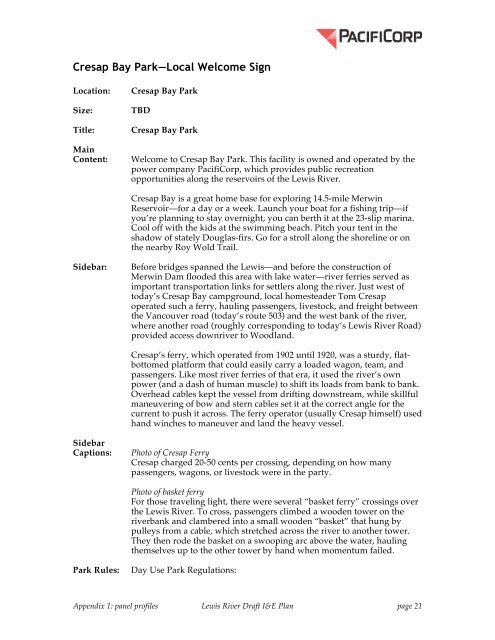The Lewis River Hydroelectric Projects - PacifiCorp
The Lewis River Hydroelectric Projects - PacifiCorp
The Lewis River Hydroelectric Projects - PacifiCorp
Create successful ePaper yourself
Turn your PDF publications into a flip-book with our unique Google optimized e-Paper software.
Cresap Bay Park—Local Welcome Sign<br />
Location:<br />
Size:<br />
Title:<br />
Main<br />
Content:<br />
Cresap Bay Park<br />
TBD<br />
Cresap Bay Park<br />
Welcome to Cresap Bay Park. This facility is owned and operated by the<br />
power company <strong>PacifiCorp</strong>, which provides public recreation<br />
opportunities along the reservoirs of the <strong>Lewis</strong> <strong>River</strong>.<br />
Cresap Bay is a great home base for exploring 14.5-mile Merwin<br />
Reservoir—for a day or a week. Launch your boat for a fishing trip—if<br />
you’re planning to stay overnight, you can berth it at the 23-slip marina.<br />
Cool off with the kids at the swimming beach. Pitch your tent in the<br />
shadow of stately Douglas-firs. Go for a stroll along the shoreline or on<br />
the nearby Roy Wold Trail.<br />
Sidebar:<br />
Before bridges spanned the <strong>Lewis</strong>—and before the construction of<br />
Merwin Dam flooded this area with lake water—river ferries served as<br />
important transportation links for settlers along the river. Just west of<br />
today’s Cresap Bay campground, local homesteader Tom Cresap<br />
operated such a ferry, hauling passengers, livestock, and freight between<br />
the Vancouver road (today’s route 503) and the west bank of the river,<br />
where another road (roughly corresponding to today’s <strong>Lewis</strong> <strong>River</strong> Road)<br />
provided access downriver to Woodland.<br />
Cresap’s ferry, which operated from 1902 until 1920, was a sturdy, flatbottomed<br />
platform that could easily carry a loaded wagon, team, and<br />
passengers. Like most river ferries of that era, it used the river’s own<br />
power (and a dash of human muscle) to shift its loads from bank to bank.<br />
Overhead cables kept the vessel from drifting downstream, while skillful<br />
maneuvering of bow and stern cables set it at the correct angle for the<br />
current to push it across. <strong>The</strong> ferry operator (usually Cresap himself) used<br />
hand winches to maneuver and land the heavy vessel.<br />
Sidebar<br />
Captions:<br />
Photo of Cresap Ferry<br />
Cresap charged 20-50 cents per crossing, depending on how many<br />
passengers, wagons, or livestock were in the party.<br />
Photo of basket ferry<br />
For those traveling light, there were several “basket ferry” crossings over<br />
the <strong>Lewis</strong> <strong>River</strong>. To cross, passengers climbed a wooden tower on the<br />
riverbank and clambered into a small wooden “basket” that hung by<br />
pulleys from a cable, which stretched across the river to another tower.<br />
<strong>The</strong>y then rode the basket on a swooping arc above the water, hauling<br />
themselves up to the other tower by hand when momentum failed.<br />
Park Rules:<br />
Day Use Park Regulations:<br />
Appendix 1: panel profiles <strong>Lewis</strong> <strong>River</strong> Draft I&E Plan page 21
















